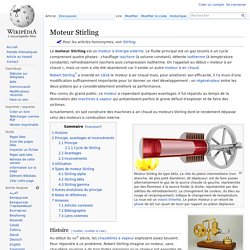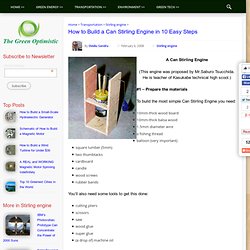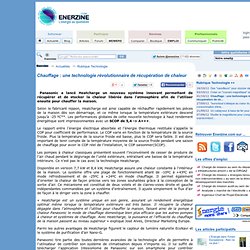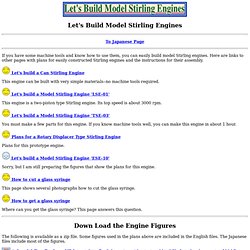

Moteur Stirling. Un article de Wikipédia, l'encyclopédie libre.

Pour les articles homonymes, voir Stirling. Le moteur Stirling est un moteur à énergie externe. Le fluide principal est un gaz soumis à un cycle comprenant quatre phases : chauffage isochore (à volume constant), détente isotherme (à température constante), refroidissement isochore puis compression isotherme. On l'appelait au début « moteur à air chaud », mais ce nom a vite été abandonné car il existe un autre moteur à air chaud.
Robert Stirling[1] a inventé en 1816 le moteur à air chaud mais, pour améliorer son efficacité, il l'a muni d'une modification suffisamment importante pour lui donner un réel développement : un régénérateur entre les deux pistons qui a considérablement amélioré sa performance. Peu connu du grand public, ce moteur a cependant quelques avantages. Actuellement, on sait construire des machines à air chaud ou moteurs Stirling dont le rendement dépasse celui des moteurs à combustion interne. Photographie d'un moteur Stirling. Vidéo Moteur Sterling. Moteur Stirling. How To Build a Stirling Engine From a Can in Your Kitchen. A Can Stirling Engine (This engine was proposed by Mr.Saburo Tsucchida.

He is teacher of Kasukabe technical high scool.) #1 – Prepare the materials To build the most simple Can Stirling Engine you need: 10mm-thick wood board10mm-thick balsa wood1.5mm diameter wirea fishing threadballoon (very important)square lumber (5mm)two thumbtackscardboardcandlewood screwsrubber bands You’ll also need some tools to get this done: cutting pliersscissorssawwood gluesuper glue(a drop of) machine oil The Can Stirling Engine uses a wood frame, its crankshaft is made out of a wire, the cylinder from a can, and the diaphragm is that important rubber balloon.
Basic view of the Can Stirling Engine #2 – Cutting the wood board appropriately You have to make two side boards, two boards to fix the can, and a bottom one. . #3 – Manufacturing the wood piston After you fit the cut balsa pieces with glue, you can glue the fishing line to the center of the piston with SuperGlue. . #4 – Cutting he diaphragm #7 – Building the frame. StirlingBuilder.com.
Chauffage : une technologie révolutionnaire de récupération de chaleur > Technologie. Panasonic a lancé Heatcharge un nouveau système innovant permettant de récupérer et de stocker la chaleur libérée dans l’atmosphère afin de l’utiliser ensuite pour chauffer la maison.

Selon le fabricant nippon, Heatcharge est ainsi capable de réchauffer rapidement les pièces de la maison dès son démarrage, et ce même lorsque la température extérieure descend jusqu’à -25 ºC**. Les performances globales de cette nouvelle technologie à haut rendement énergétique sont impressionnantes avec un SCOP de 5,4 -> A+++. Le rapport entre l’énergie électrique absorbée et l’énergie thermique restituée s’appelle le COP pour coefficient de performance. Le COP varie en fonction de la température de la source froide. Plus la température de la source froide est basse, plus le COP sera faible. Les pompes à chaleur classiques présentent souvent l’inconvénient de cesser de produire de l’air chaud pendant le dégivrage de l’unité extérieure, entraînant une baisse de la température intérieure. Let's Build A Can Stirling Engine Step 7.
You will construct the wood frame (See the Step 2). When you construct the frame, you must make sure that the crank shaft can rotate with a very small friction loss. Go to Before Page --- Go to Next Page Return to 'Let's Build a Can Stirling Engine' Return To 'Let's Build Model Stirling Engines' Go to Stirling Engine Home Page Koichi Hirata. Let's Build Model Stirling Engines -English- Let's Build Model Stirling Engines To Japanese Page If you have some machine tools and know how to use them, you can easily build model Stirling engines.

Here are links to other pages with plans for easily constructed Stirling engines and the instructions for their assembly. Let's build a Can Stirling Engine This engine can be built with very simple materials--no machine tools required. Let's build a Model Stirling Engine 'LSE-01' This engine is a two-piston type Stirling engine.